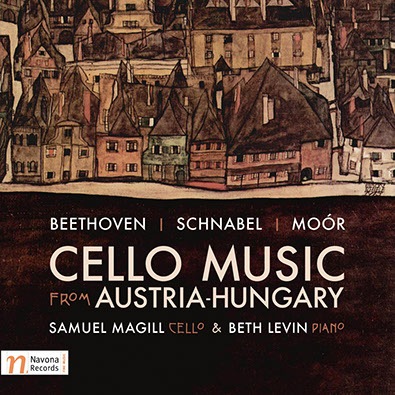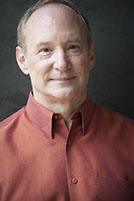
YouTube | Amazon | iTunes | Spotify | ArKiveMusic
Release Date: February 12, 2016
Catalog #: NV6024
TRACK TITLES
Samuel Magill, Cello; Beth Levin, Piano
Sonata in A Major, op. 47 “Kreutzer” Ludwig van Beethoven
Transcribed from the Violin and Piano original by Carl Czerny and Auguste Franchomme
1 I. Adagio sostenuto – presto
2 II. Andante con Variazioni
3 III. Presto
Sonata for Solo Cello Artur Schnabel
4 I. Allegro con moto
5 II. Allegretto
6 III. Larghetto
7 Iv. Vivace ma non troppo
8 Ballade in E Major, op. 171 (1913) Emanuel Moór
(World Première Recording)
CELLO MUSIC FROM
AUSTRIA-HUNGARY
Beethoven | Schnabel | Moór
OVERVIEW
The regions of Austria and Hungary have a rich history of music, art, and culture, where composers such as Beethoven, Artur Schnabel, and Emanuel Moór, among many others, developed their craft and influenced the traditions of European art music. On his debut release on Navona Records, CELLO MUSIC FROM AUSTRIA-HUNGARY, cellist Sam Magill presents works by Beethoven, Schnabel, and Moór that not only expand the cello repertoire and illustrate the cellist’s virtuosity, technical aplomb, conviction, and expressiveness, but enrich our understanding of these composers, their music, and their heritage.
An extensive and demanding work, Beethoven’s Violin Sonata No. 9, Op. 47 (1803) is a virtuosic piece originally written for violinist George Bridgetower (1779-1860), yet dedicated to Rodolphe Kreutzer who never actually played the Sonata. Working from an 1822 arrangement of the piece for cello and piano by Beethoven’s pupil Carl Czerny, Magill and pianist Beth Levin perform the challenging work with aplomb and austerity, restoring certain passages from the original manuscript to expose the Sonata’s virtuosic elements while retaining clarity of sound.
Artur Schnabel (1882-1951), a gifted pianist and composer who was influenced by Arnold Schoenberg’s 12-tone system as well as other less restrictive atonal techniques, wrote Sonata for Solo Cello in 1931, utilizing Schoenberg’s concept of developing variation, with passages reminiscent of the extreme chromaticism of Max Reger. Incorporating one of Schnabel’s unique compositional techniques of Aposiopesis, the use of frequent stops and gaps in the music, the Sonata creates a manic fleeing from one direction and emotion to another, eventually fading eerily away to nothing.
To finish off the program, Magill and Levin present the world premiere recording of Ballade for Cello and Orchestra, in E Major, Op. 171 by Emanuel Moór (1863-1931), a piece that is late-Romantic in language, with moments of nationalistic themes and virtuosic passages. It was dedicated to Pau Casals in 1913 but was never published. In 2010 a version for cello and piano which the composer made himself was engraved by the Henrik and Emanuel Moór Society, and which Magill and Levin evocatively present here.
HIGHLIGHTS
Samuel Magill’s played is called “flat-out magnificent” (American Record Guide), with “sumptuous tone” (Strad Magazine) and “unimpeachable reading” (New York Times)
Magill has appeared as soloist throughout Japan and the United States, including performances in Tokyo's famed Suntory Hall and in New York’s Alice Tully Hall at the Lincoln Center
He has given annual recitals since 1994 at the New York Public Library for the Performing Arts, and is a co-founder of The Elysian Ensemble, a flute, cello and harp trio which made their New York debut at Weill Recital Hall at Carnegie Hall to critical acclaim
He is currently a member of the Metropolitan Opera Orchestra in New York, and has been a member of the Pittsburgh Symphony and the Houston Symphony orchestras
Pianist Beth Levin, who has been praised by the New York Times for her “boldly inflected readings and impressive ability to convey emotion without exhibition,” has two albums on Navona Records, A SINGLE BREATH (2013) and PERSONAE (2016)
 Samuel Magill, Cello
Samuel Magill, Cello
Praised in the September/October 2015 issue of Fanfare Magazine, cellist Samuel Magill has had a rich and varied career as soloist and chamber musician. James Forrest said of his Centaur release of Andrew Rudin’s Cello Sonata, “Throughout, Magill’s beautiful cello tone is in evidence, endlessly expressive, subtle in shading. Rudin is presently writing a composition for solo cello for this Metropolitan Opera Orchestra member, a first rate artist and instrumentalist.” His first Naxos album of the Cello Concerto of Vernon Duke was hailed as “flat-out magnificent” by the American Record Guide, while The Strad wrote in 2010 of his world premiere recording of Franco Alfano’s Cello Sonata “...Magill’s husky, dark timbre matches the Cello Sonata’s yearning intensity to perfection....” The June, 2014 STRAD Magazine raved about Magill’s “sumptuous tone” in his March 2014 recital at Bargemusic in New York, in which he and Beth Levin performed the rarely heard Czerny transcription of Beethoven’s “Kreutzer” Sonata. Magill has appeared as soloist throughout Japan and the United States, including performances of the Schumann Concerto and Brahms Double Concerto in Tokyo’s famed Suntory Hall and in Alice Tully Hall. Magill has partnered with the pianists Oxana Yablonskaya, Pascal Rogé, Beth Levin, and the late Grant Johannesen, and has given annual recitals since 1994 at the New York Public Library for the Performing Arts. He is a co-founder of The Elysian Ensemble, a flute, cello, and harp Trio. They made their New York debut at Weill Recital Hall at Carnegie Hall to critical acclaim. Strings Magazine declared them “masters of their instruments.”
A pupil of the late Zara Nelsova, Magill was educated at the Peabody Institute and Rice University. He is currently a member of the Metropolitan Opera Orchestra in New York, and was formerly Associate Principal Cello. He was for nine summers Principal Cello and Soloist of the New York Symphonic Ensemble. As such he toured throughout Japan playing the concerti of Tchaikovsky, Saint-Saens, Dvorak, Dohnanyi, Schumann, Brahms, and Beethoven. Three of these performances were recorded live by Panasonic. Magill was also a member of the Pittsburgh Symphony and the Houston Symphony. www.samuelmagill.com
 Beth Levin, Piano
Beth Levin, Piano
Beth Levin’s artistry invokes an uncanny sense of hearing for the first time works long thought familiar, as though the pianist herself were discovering a piece in the playing of it. Such a style of refreshment and renewal can be traced back to Levin’s unique artistic lineage. As a child prodigy, she made her debut with the Philadelphia Orchestra at age 12. She was subsequently taught and guided by legendary pianists such as Rudolf Serkin, Leonard Shure, Dorothy Taubman, and Paul Badura-Skoda (who praised her as “a pianist of rare qualities and the highest professional caliber”). Her deep well of experience allows Levin to reach back through the golden age of the Romantic composers and connect to the sources of the great pianistic traditions, to Bach, to Mozart, to Beethoven.
Levin has appeared as a concerto soloist with numerous symphony orchestras, including the Philadelphia Orchestra, the Boston Pops Orchestra, the Boston Civic Symphony, and the Seattle Symphony Orchestra. Levin has worked with noted conductors such as Arthur Fiedler, Tonu Kalam, Milton Katims, Joseph Silverstein, and Benjamin Zander. Chamber music festival collaborations have brought her to the Marlboro Festival, Casals Festival, Harvard, the Edinburgh Fringe Festival, the Ankara Music Festival, and the Blue Hill Festival, collaborating with groups such as the Gramercy Trio (founding member), the Audubon Quartet, the Vermeer Quartet, and the Trio Borealis, with which she has toured extensively.
Among Levin’s recordings are live performances of Bach’s Goldberg Variations (Centaur Records, 2008), and Beethoven’s Diabelli Variations (Centaur Records, 2011). Her interpretation of the Diabelli Variations has been described as “consistently fascinating” (Steve Smith, NY Times) and simply “stunning” (Robert Levine, Stereophile Magazine). Of Levin’s Goldberg Variations, Peter Burwasser of Fanfare Magazine stated that she plays “as if she is in love with the notes...with always the sense that she is exploring Bach’s genius.” Her performances have been broadcast on National Public Radio, WGBH (Boston), WFMT (Chicago) and WNYC, WNYE, and WQXR (New York).
For all her devotion to the Romantic canon, Levin remains committed to the performance of the music of our time, interpreting composers such as Henryk Górecki, Scott Wheeler, Roger Stubblefield, Frank Warren, Mohammed Farouz, and Michael Rose, among many others. Her closest collaborators have been the composers David Del Tredici and Andrew Rudin, both of whom have written works for her. www.bethlevinpiano.com

© NAVONA RECORDS LLC. ALL RIGHTS RESERVED.
Navona Records offers listeners a fresh taste of today's leading innovators in orchestral, chamber, instrumental, and experimental music as well as prime pieces of classic repertoire. Our music is meticulously performed by the finest musicians and handpicked to ensure the most rewarding listening experience.
223 Lafayette Road
North Hampton NH 03862
PRESS INQUIRIES
press (at) parmarecordings.com
603.758.1718 x 161
